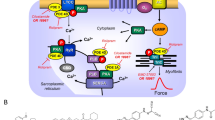Summary
We studied the effect of a new positive inotropic agent, OPC-8212 (3,4-Dihydro-6-[4-(3,4-dimethoxybenzoyl)-l-piperazinyl]-2(1H)-quinolinone), on the relation between left ventricular oxygen consumption (VO2) and pressure-volume area (PVA) in excised cross-circulated dog hearts. PVA represents the total mechanical energy generated by ventricular contraction. OPC-8212 increased the contractility index, Emax, by 59%±36% from 7.6±4.3 to 11.1±4.6 mmHg/(ml/100 g LV [leftventricle]). OPC-8212 elevated the VO2-PVA relation without a significant change in its slope. Namely, OPC-8212 did not affect the mechanical efficiency of the contractile machinery from the PVA-dependent fraction of VO2 to PVA, but increased the PVA-independent fraction of VO2 which is related with non-mechanical processes of contraction. This effect suggested an increased energy expenditure for excitation-contraction coupling. These results associated with the enhanced contractile state by OPC-8212 were both qualitatively and quantitatively similar to those obtained with catecholamines and calcium in our previous study. This suggests that OPC-8212, catecholamines, and calcium have similar effects on intracellular Ca2+ concentration and enhanced ventricular contractility.
Similar content being viewed by others
References
Katz AM (1984) Excitation-contraction coupling and Ca2+. In: Abe H (ed) Regulation of cardiac function. Japan Scientific Societies Press, Tokyo, pp 3–9
Gibbs CL (1978) Cardiac energetics. Physiol Rev 58: 174–254
Tominaga M, Yo E, Ogawa H, Yamashita S, Yabuuchi Y, Nakagawa K (1984) Studies on positive inotropic agent. I. Synthesis of 3,4-dihydro-6-[4-(3,4-dimethoxybenzoyl)-1-piperazinyl]-2(1H)-quinolinone and related compounds. Chem Pharm Bull 32:2100–2110
Taira N, Endoh M, Iijima T, Satoh K, Yanagisawa T, Yamashita S, Maruyama M, Kawada M, Morita T, Wada Y (1984) Mode and mechanism of action of 3,4-dihydro-6-[4-(3,4-dimethoxybenzoyl)-1-piperazinyl]-2(1H)-quinolinone (OPC-8212), a novel positive inotropic drug, on the dog heart. Arzneimittelforsch / Drug Res 34: 347–355
Endo M (1984) The effect of a new positive inotropic agent, 3,4-dihydro-6-[4-(3,4-dimethoxybenzoyl)-1-piperazinyl]2-(1H)-quinolinone (OPC-8212) on thin bundles of skinned fibers from cardiac muscle. Arzneimittelforsch / Drug Res 34: 380–383
Endoh M, Yanagisawa T, Taira N, Blinks JR (1986) Effects of new inotropic agents on cyclic nucleotide metabolism and calcium transients in canine ventricular muscle. Circulation 73 (Suppl III): III-117–III-133
Miyazaki S, Sasayama S, Nakamura Y, Kihara Y, Susawa T, Kawai C (1986) Acute hemodynamic effects of a new positive inotropic agent, 3,4-dihydro-6-[4-(3,4-dimethoxybenzoyl)-1-piperazinyl]-2(1H)-quinolinone (OPC-8212), in conscious and anesthetized dogs. J Cardiovasc Pharmacol 8: 14–20
Grupp G, Grupp IL, Kojima M, Sperelakis N, Tsuchiya Y, Hosokawa T, Schwartz A (1986) Hemodynamic and electrophysiological effects of a novel positive inotropic drug, OPC-8212, in normal and “failing” guinea pig heart preparation. J Cardiovasc Pharmacol 8: 428–440
Sasayama S, Inoue M, Asanoi H, Kodama K, Hori M, Sakurai T, Kawai C (1986) Acute hemodynamic effects of a new inotropic agent, OPC-8212, on severe congestive heart failure. Heart Vessels 2: 23–28
Maruyama Y, Nishioka O, Watanabe J, Keitoku M, Satoh S, Isoyama S, Ashikawa K, Ino-Oka E, Takishima T (1986) Effect of OPC-8212, a new positive inotropic agent, and dobutamine on left ventricular global and ischemic regional functions and coronary hemodynamics under coronary artery stenosis. J Cardiovasc Pharmacol 8: 161–169
Suga H (1979) Total mechanical energy of a ventricle model and cardiac oxygen consumption. Am J Physiol 236: H498-H505
Suga H, Hisano R, Goto Y, Yamada O, Igarashi Y (1983) Effect of positive inotropic agents on relation between oxygen consumption and systolic pressure-volume area in canine left ventricle. Circ Res 53: 306–318
Nazawa T, Yasumura Y, Futaki S, Tanaka N, Igarashi Y, Goto Y, Suga H (1987) Relation between oxygen consumption and pressure-volume area of in situ dog heart. Am J Physiol 253: H31-H40
Suga H, Hayashi T, Shirahata M (1981) Ventricular systolic pressure-volume area as predictor of cardiac oxygen consumption. Am J Physiol 240: H39-H44
Suga H, Hayashi T, Shirahata M, Suehiro S, Hisano R (1981) Regression of cardiac oxygen consumption on ventricular pressure-volume area in dog. Am J Physiol 240: H320-H325
Shepherd AP, Burgar CG (1977) A solid-state arteriovenous oxygen difference analyzer for flowing blood. Am J Physiol 232: H437-H440
Suga H, Sagawa K, Shoukas AA (1973) Load independence of the instantaneous pressure-volume ratio of the canine left ventricle and effect of epinephrine and heart rate on the ratio. Circ Res 32: 314–322
Suga H, Sagawa K (1974) Instantaneous pressure-volume relationship and their ratio in the excised, supported canine left ventricle. Circ Res 35: 117–126
Suga H, Hisano R, Ninomiya I (1982) Digital on-line computation of a predictor of cardiac oxygen consumption. Left ventricular pressure-volume area. Jpn Heart J 23: 749–758
Suga H, Goto Y, Yasumura Y, Nozawa T, Futaki S, Tanaka N, Uenishi M (1988) O2 consumption of dog heart under decreased coronary perfusion and propranolol. Am J Physiol 254: H292-H303
Snedecor GN, Cochran WG (1980) Statistical Method (7th ed.) Iowa State University Press, Ames, Iowa, pp 365–388
Klocke FJ, Kaiser GA, Ross J, Braunwald E (1965) Mechanism of increase of myocardial oxygen uptake produced by catecholamines. Am J Physiol 209: 913–918
Klocke FJ, Braunwald E, Ross J (1966) Oxygen cost of electrical activation of the heart. Circ Res 18: 357–365
Suga H, Igarashi Y, Yamada O, Goto Y (1985) Mechanical efficiency of the left ventricle as a function of preload, afterload, and contractility. Heart Vessels 1: 3–8
Burkhoff D, Yue DT, Oikawa RY, Franz MR, Schaefer J, Sagawa K (1987) Influence of ventricular contractility on non-work-related myocardial oxygen consumption. Heart Vessels 3: 66–72
Tada M, Yamamoto T, Tonomura Y (1978) Molecular mechanisms of active calcium transport by sarcoplasmic reticulum. Physiol Rev 58: 1–79
Author information
Authors and Affiliations
Additional information
Partly supported by a Grant-in-Aid (61480102) for Scientific Research from the Ministry of Education, Science, and Culture, and a Research Grant (60C-3) for Cardiovascular Diseases from the Ministry of Health and Welfare of Japan.
Rights and permissions
About this article
Cite this article
Futaki, S., Nozawa, T., Yasumura, Y. et al. A new cardiotonic agent, OPC-8212, elevates the myocardial oxygen consumption versus pressure-volume area (PVA) relation in a similar manner to catecholamines and calcium in canine hearts. Heart Vessels 4, 153–161 (1988). https://doi.org/10.1007/BF02058428
Received:
Accepted:
Issue Date:
DOI: https://doi.org/10.1007/BF02058428




